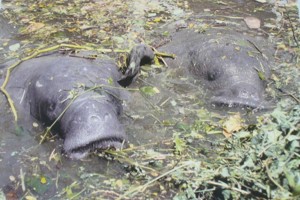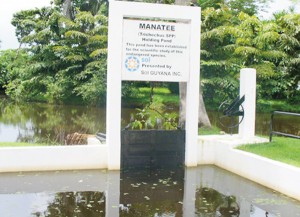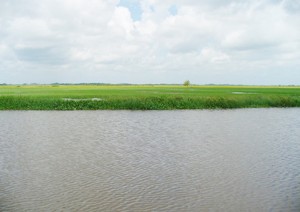Manatees, found mainly in the Abary Creek, are vulnerable to extinction with their main threat being human predators and environmentalists are calling for them to be protected.

During a recent visit to the Abary Creek, residents told Stabroek News that the manatees were being caught and eaten by persons from outside the area. They said that they would not harm the animals as they are aware that they are an endangered species.
The residents recalled that in the past businesspersons would visit the area and shoot the manatees or trap them with seines. They would then sell some of the meat locally and export the other portion. The predators would also block the channels to capture the smaller manatees.
The practice of “doing business” with the animals has stopped since environmentalists of the Mahaica-Mahaicony-Abary scheme (MMA) have been vigilant in the area.

Farmers told this newspaper that the manatees are normally spotted farther up in the creek between 6 am and 7 am when they come up to feed. But they observed that the animals would now instinctively dive for cover as soon as they heard the noise of an engine.
According to them, the manatees would also be seen at the top of the creek during the rainy season when it is cool. During the dry season, they would spend most of their time “at the bottom because the water-top is too hot for them.”
Manatees, also known as water cows, are herbivorous. They eat aquatic plants and can consume 10-15% of their body weight in vegetation. They have been known to rid the waterways of weeds.
They have also faced the danger of being hit by boats that traverse the creek when they venture up to the surface to breathe or to feed.
Environmental research
A former environmental officer with MMA, Rabindranauth Saywack, related that at one time a boat he was travelling in struck a manatee and the rear of the boat was broken on impact. He also remembered seeing another manatee with a huge wound on its back and suspected that it might have been hit by another boat.

Saywack was part of the Environmental Monitoring Unit (EMU) team that conducted a study of the manatees with funding from the Inter-American Development Bank (IDB). He said that during the 1980s, a baseline study/inventory was conducted on the flora and fauna as well as the water quality in the MMA area.
The EMU was subsequently formed to verify the existing stocks and ecological characteristics. The manatee, he said “was identified as a benchmark in terms of the change in water quality and weed proliferation. This gave rise to the population count of the manatees resulting in proposal of their management…”
According to Saywack, it was found that the “manatee population was on the increase as they had been sighted more often in areas such as Water Hass Creek, Distress Creek, Bullet Tree Savannah and Duck Pond.
“There were also sightings of large herds in the Blairmont Water Path, Old Bath Pump Station, Bush Lot/Onverwagt areas and as far down as the old railway line.”
Restriction
He said that in the 90s, reports of a manatee being slaughtered in the Bush Lot area had caused the MMA to implement a restriction. The EMU in association with consultant, CMR Pastakia, also drafted an environmental regulation.

But he said the status of the regulation is still unknown and he is not sure if it had been added to the MMA Act.
Contacted, General Manager of MMA, Aubrey Charles, told this newspaper that he was not aware that manatees existed in the Abary Creek. However, he recalled that the EMU was conducting studies in the area.
Charles, who was not part of the EMU, mentioned too that most of the persons who would have been able to provide information are no longer attached to MMA. He said too that information on the study may have been destroyed in a fire which gutted the previous MMA building.
Saywack also pointed out that in the 1980s, a calf, just a few weeks old, washed up on the shore at Hopetown and residents were about to slaughter it. However, the EMU received a report and immediately rescued it and donated it to the zoo.
He said there were indications that the calf may have been flung over the spill weir during the high tide and into the Berbice River.
He reiterated that in the past the slaughtering and exporting of the ‘sea-cows’ were done openly but after persons became aware that the practice was illegal they would slaughter them in the creek and remove the meat.
Bio-weed control
Through the EMU, Saywack said, MMA had instituted a pilot project using manatees in bio-weed control. But sadly the project had to be discontinued because of a lack of technology.
He said six animals were placed in the Lengths 1 and 2 of the Main Canal but were apparently stolen.
He related that the technology required in the study included electronic devices and cameras which were to be attached to the manatees. Staff would have been able to monitor the manatees to confirm whether they could have been used in the biological control of weeds.
“This could have saved MMA millions of dollars in its weed control programme and assisted in the effective management of the scheme. The manatees would have become an invaluable tool…”
He explained, “The amount of water loss by evaporation, transportation and clogging by aquatic would have been so great it would have rendered the conservancy ineffective…”
He posited that if the stocks were managed properly there would have been less clogging. He pointed out that MMA needs to reactivate the EMU “with strict guidelines for the management and conservation of the manatees as well as the ecological parameters of birds, fish and caimans.”
“The baseline study became naught when the information could have been used in the phase two and three of the scheme,” he said.
According to another environmentalist, “IDB funded the project for ten years initially but because of the importance, funding was provided for an additional five years.”
Manatees clearing vegetation at Den Amstel
Peter Kato of the National Parks Commission (NPC) told Stabroek News that the study of the manatees clearing the vegetation was also done by Harman (only name given), a student of the University of Guyana.
Harman who later became the “project manager of IFAD – International Federation of Agricultural Development – an East Bank Essequibo developmental project, took two manatees to Den Amstel to help with the vegetation.”
He said the manatees which have since been “joined by a baby were sent to the area as a pilot project.”
Harman has left IFAD and the manatee project has fallen apart but the animals continue to effectively rid the trenches of vegetation.
Staff of the NPC would also make regular checks to ensure that the manatees are safe and have not fallen prey to humans.
He related that two manatees have also been placed in the Lama Canal and are assisting in clearing that waterway, but this is also being done manually, because of the volume of the vegetation.
Manatees sent to Spain
General Manager of the NPC, Yolanda Vasconcellos, told Stabroek News in an interview that there are 23 manatees – scientific names manatus-manatus or trichechus manatus – between the Botanical Gardens and the National Park.
They have been there for more than 129 years and reports are that they came from the Abary Creek. The manatees are first placed in a “holding pond” at the Botanical Gardens where scientific studies are conducted.
Two of the manatees have been loaned to Spain for a display and for research to accessing the genetic pool. They were transported aboard a plane specially chartered by that country.
Vasconcellos acknowledged that “research is always important to monitor the manatees and track them to see how fast an area regenerates… but because of funding monitoring is not how we would like it to be.”
Vasconcellos shares the view that the manatees would save entities a lot of money and feels that MMA should “channel them [manatees] to areas that are clogged.”
She stressed that the advantage in doing so is that “they [the authorities] would not have to burn fuel or pollute the environment with carbon monoxide.”
But she said moving, which is not just a costly exercise, should not be done to the “detriment of the animals or with any amount of stress.”
Apart from saving financially, the “manatees cause no trouble. They are vegetarians and are harmless; do not attack anyone. They take a long time to be domesticated but persons can still pet them.”
She said there are no plans to remove the animals from Den Amstel unless there are reports of residents trying to capture them.
Vasconcellos emphasized the need for persons to be educated about the manatees. “The first step,” she said, “should be awareness about their use and benefits especially when they are out in the wild and at risk. By nature they are not aggressive; they would rather run from danger.”
She said if they were put in waterways their security should come first.
Curious animals
Donald Gunraj, lecturer of the Nature School, described the manatees which care for their young for two years or longer as “curious animals; they would come up to investigate anything.”
He said while the manatees did not harm anyone their tail may inflict an injury as they attempt to escape.
He recalled an incident in which a manatee was blamed for causing a canoe to capsize and a child to drown in the Pomeroon River about seven years ago.
Investigations later revealed that the manatee had come up to eat when the canoe accidently passed over it and it apparently responded by “shrugging it off.”
The incident had prompted residents to resort to “drastic action by getting rid of all of the manatees. We [a team] had to go in the area to educate them and dissuade them from taking that course of action.”
Had lived on land
Gunraj said studies prove that “many years ago the manatees lived on land and as time evolved their bodies became elongated. They lost the use of the hind legs and they then adapted to a life in water.”
He said the animals still have nails on their flippers as evidence that the hind legs existed. “It is quite interesting,” he said, noting “that though they are aquatic their closest relative is the elephant.”
He said the manatees which are “continuously slouching have wrinkled skin.” Gunraj explained too that they have “marching molars” – teeth which move like a conveyor belt and erupt from the back and move to the front.
“Manatees belong to an order called Sirenia. There are three species of manatees and all three species are listed by the World Conservation Union as vulnerable to extinction,” Gunraj pointed out.
If their numbers do not increase and their habitats are not protected, they might not survive. To add to their problems, manatees have a very slow reproductive cycle. Cows give birth only once every three to five years.
Gunraj too is issuing a call for the manatees to be protected instead of them being wiped out like the Steller’s Seacow or Rhytima. That species, he said had “become extinct at the hands of man within 27 years of its discovery.”





